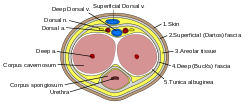Tunica albuginea (penis)
| Tunica albuginea (penis) | |
|---|---|
 The penis in transverse section with tunica albuginea shown | |
 Transverse section of the penis | |
| Details | |
| Identifiers | |
| Latin | tunica albuginea corporum cavernosorum, tunica albuginea corporis spongiosi |
| TA98 | A09.4.01.017 A09.4.01.018 |
| TA2 | 3593 |
| FMA | 19630 |
| Anatomical terminology | |
The tunica albuginea is the fibrous envelope that extends the length of the corpus cavernosum penis and corpus spongiosum penis. It is a bi-layered structure that includes an outer longitudinal layer and an inner circular layer.[1]
Structure
[edit]Microstructure
[edit]The trabeculae of the tunica albuginea are more delicate, nearly uniform in size, and the meshes between them smaller than in the corpora cavernosa penis: their long diameters, for the most part, corresponding with that of the penis.[citation needed]
The external envelope or outer coat of the corpus spongiosum is formed partly of unstriped muscular fibers, and a layer of the same tissue immediately surrounds the canal of the urethra.[citation needed]
It consists of approximately 5% elastin, with the remainder mostly consisting of collagen.[2]
Function
[edit]The tunica albuginea is directly involved in maintaining an erection; that is due to Buck's fascia constricting the erection veins of the penis, preventing blood from leaving and thus sustaining the erect state.[clarification needed][citation needed]
Additional images
[edit]-
Medical ultrasonography of a normal penis
References
[edit]![]() This article incorporates text in the public domain from page 1250 of the 20th edition of Gray's Anatomy (1918)
This article incorporates text in the public domain from page 1250 of the 20th edition of Gray's Anatomy (1918)
- ^ "Penis Anatomy: Gross Anatomy, Vasculature, Lymphatics and Nerve Supply". 2019-07-01.
{{cite journal}}: Cite journal requires|journal=(help) - ^ "Male Genital Anatomy » Sexual Medicine » BUMC".
External links
[edit]- Anatomy photo:42:07-0103 at the SUNY Downstate Medical Center - "The Male Perineum and the Penis: The Corpus Spongiosum and Corpora Cavernosa"
- Image at downstate.edu
- Image at downstate.edu
- Histology image: 17703loa – Histology Learning System at Boston University
- Encyclopedia of Reproduction

